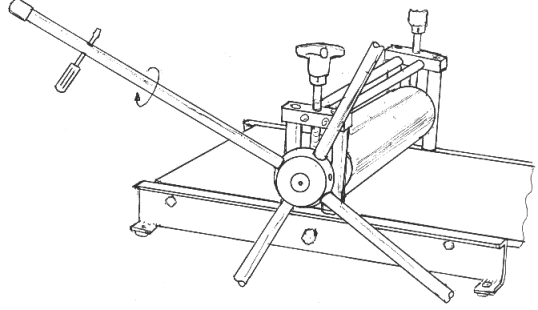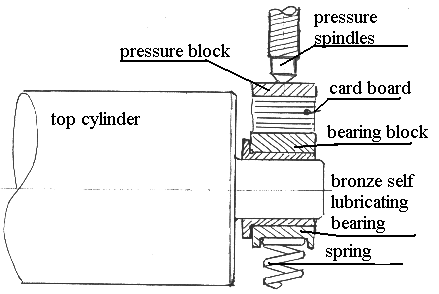|
User's instructions, Polymetaal etching press HS-35
Description of the press;
Combining manageable design (30kg), a reasonable bed size and a very affordable price, this press is highly favoured by schools and other institutions. The HS-35 can easily be stored away by removing the four spokes from the hub. The press is upper roller driven. Like all our other intaglio presses, the construction with springs facilitates relief printing (lino, mono and wood-cuts). The upper roller comes with self lubricating bronze bearings. The lower roller has closed ball bearings. The press is delivered in a sturdy cardboard box.
Assembly
In the card board container you find the following items:
-
the etching press
-
the bed plate
-
the four spokes, packed in paper.
-
it is possible that you find the two screw spindels (with the black "plastic" knobs) are put into the box seperately, to avoid damage to these spindles during transport.
If the pressure spindles are seperate, take the replacing bolts out of the threaded holes on the top end of the side frames, and screw the pressure spindels in.
The spokes have ends with screwthread. This allows you to screw the spokes into the hub. Fix them well by turning them firmly with the help of a srew driver.

Use of the press
This press is very well suitable for printing intaglio (copper and zinc plates) as well as woodcuts and linocuts.
The following drawing shows the situation while printing from an etched or engraved metal plate. (intaglio)

The purpose of the felt is to press the paper into the small engraved lines of the plate, in order to accept ink.
Some people use cardboard shims under the pressure spindle to generate more "flexibility" in the press. For etching is has not much effect, but for printing woodcuts or linocuts it can be of help. It helps to compensate the iragularities of the wood's surface. The next drawing shows the location of the card board;

Printing woodcuts and linocuts with this press

The drawing shows a layer of felt. This felt has also the feature to compensate for irregularities of the woodcut or linocut. (differences in thickness). If the woud or lino should be perfectly plane, no felt was needed. Underneath the felt is a plastic layer (PVC) of appr. 5mm thick. This is only functional in combination with the felt. If the PVC layer should not be used, the felt would press the paper into the hollows of the woodcut or linocut. If you want embossing, very well. If not, prevent this from happening by using the plastic layer.
Maintenance
-
The bearings of this do not need lubrification.
-
It is recommanded to use and store this press in a dry room, to prevent rusting. (For example, etching with aggressive agents should be done in a different room, for the same reason)
Use the "back-button" to go back to the HS-35 page.
|